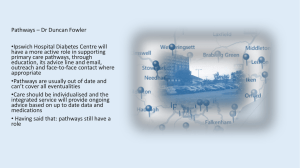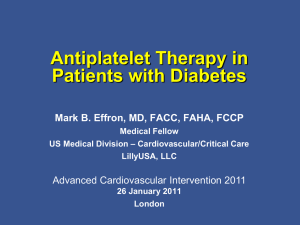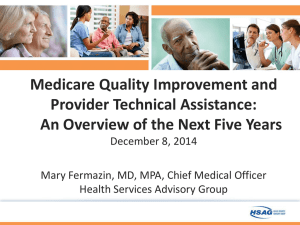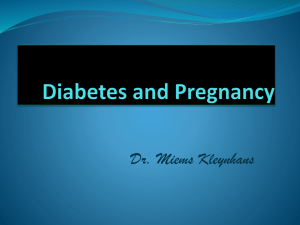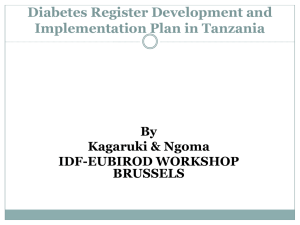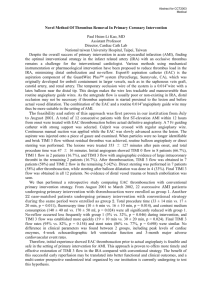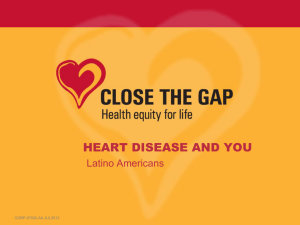0900_Braunwald - his
advertisement
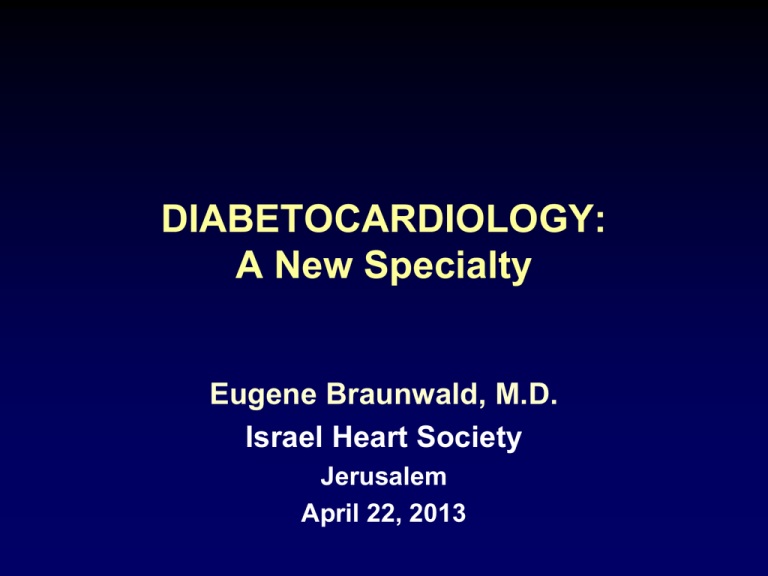
DIABETOCARDIOLOGY: A New Specialty Eugene Braunwald, M.D. Israel Heart Society Jerusalem April 22, 2013 Disclosures Research Support for Clinical Trials Squibb Bristol Myers Squibb Astra Zeneca SAVE, CARE PROVE IT (TIMI 22) SAVOR (TIMI 53) SAVOR (TIMI 53) Lilly/Daiichi Sankyo TRITON (TIMI 38) ENGAGE (TIMI 48) Johnson & Johnson ATLAS 2 (TIMI 51) GSK Merck SOLID (TIMI 52) TRA-2P (TIMI 50) REVEAL (TIMI 55) 1 YEAR MORTALITY AFTER ACS 14 diabetic P interaction DM x ACS = 0.004 13.2% Mortality (%) 12 STEMI 10 8.1% 7.2% 8 diabetic 6 UA/NSTEMI 4 3.1% 2 0 30 90 180 270 360 Days Non DM + STEMI Non DM + UA/NSTEMI DM+ STEMI DM + UA/NSTEMI Donahoe SM et al. JAMA 2007;298:765 2004;350:1495 0.03 0.02 Pravastatin 0.01 Atorvastatin 33% RR p = .043 0.0 Death, MI, Urgent Revasc 0.04 ALL-CAUSE DEATH, NON-FATAL MI, OR URGENT REVASCULARIZATION 0 5 10 15 20 25 30 Time after entry to trial (days) Ray KK, Cannon CP, Braunwald E et al. JACC 2005;46:1405 Eur Heart J 2006;27:2323 Ahmed S et al. Eur Heart J 2006;27:2323 PLATELET CASCADE IN THROMBUS FORMATION 1 Adhesion von Willebrand Platelets Factor/GP lb bind Collagen GP la/lla bind 2 Lipid core Activation Thrombin ADP 5 HT TXA2 3 Activated GP llb/llla Handin RI. Harrison’s Principles of Internal Medicine. Vol 1. 14th ed. NY, NY: McGraw-Hill; 1998:339. Schafer AI. Am J Med. 1996;101:199-209. Aggregation Fibrinogen Ann Intern Med 1975;82:733 % Aggregation RESPONSE OF NORMAL AND DIABETIC PLATELET-RICH PLASMA TO ADENOSINE Minutes Sagel J et al. Ann Int Med 1975;82:733 ASA INHIBITION OF ARACHIDONIC ACID-INDUCED PLATELET AGGREGATION Inhibition [%] 80 70 60 50 40 30 20 Control sDM 10 0 0 10 20 30 40 50 60 70 80 90 100 ASA concentration [mg/ml] Watala C et al Thrombosis Res 2004;113:101 N Engl J Med 2007;357:2001 Balance of Efficacy and Safety 15 138 events Clopidogrel Endpoint (%) 12.1 CV Death / MI / Stroke 9.9 10 HR 0.81 (0.73-0.90) P=0.0004 NNT = 46 Prasugrel 5 TIMI Major NonCABG Bleeds Prasugrel 2.4 HR 1.32 1.8 (1.03-1.68) Clopidogrel P=0.03 0 0 30 60 90 180 270 Days 35 events 360 450 NNH = 167 Wiviott SD et al. NEJM 2007;357: 2001 Myocardial Infarction DM No DM 0.15 0.15 15 15 13.2 120.12 0.12 12 90.09 0.09 9 8.2 % 60.06 60.06 30.03 0 8.7 7.2 % 0.03 3 HR 0.60 (0.48-0.76), <0.001 n=3146 HR 0.82 (0.72-0.985, 0.006 n=10,467 DM Clopidogrel DM Prasugrel 0 0 0 100 100 200 200 300 300 400 400 500 0 500 P interaction = 0.02 0 100 100 200 200 300 300 Days clopidogrel No DMPrasugr 0 0 Days No DM Clopido prasugrel 400 400 500 500 Pras Clop Reduction in Risk No DM n=10,462 9.2% 10.6% 14% DM No Insulin n=2340 11.5% 15.3% 26% DM on Insulin n=776 14.3% 22.2% 37% 0.3 1 Prasugrel Better 2 Clopidogrel Better IONIC DISTURBANCES IN ISCHEMIA AND HEART FAILURE AND THEIR CONSEQUENCES Ischemia Heart Failure Na+ Overload Ranolazine Reverse Late INa is increased by (in) Hypoxia Ischemic metabolites O2 reactive species Heart failure Post-MI remodelled myocytes Na+/Ca2+X Ca2+ Overload Dysfunction 1. Electrical 2. Mechanical Arrhythmias Abn. Contractility diastolic tension (-) force-freq. relation ATP Hydrolysis Cell Injury Assessment of Anti-anginal Effects PLACEBO (N=3,281) 23% P = 0.023 % RANOLAZINE (N=3,279) 19% P = 0.006 % 8 16 7 14 5.9 6 5 12.2 12 4.2 10 10 4 8 3 6 2 4 1 2 0 0 Worsening Angina (%)* Results Antianginal Increase (%)* *KM Cumulative Incidence at 12 months Circulation 2009;119:2032 MERLIN-TIMI 36: CHANGE IN HbA1c (%) STRATIFIED BY DIABETES STATUS No Diabetes Mellitus Patients with Diabetes Mellitus Month of Follow-up 0 4 8 12 Month of Follow-up 0 16 8 12 16 0.4 0.4 LS Mean baseline (Ran) 7.5% LS Mean baseline (Ran) 5.6% 0.2 0.2 0 0 -0.2 -0.2 -0.4 -0.4 -0.6 4 -0.12 -0.6 -0.64 -0.8 -0.8 M4 M8 Placebo N = 770 N = 598 RanolazineN = 707 N = 535 P-value <0.001 <0.001 M16 N = 122 N = 112 = 0.16 Morrow DA et al. Circulation. 2009;119:2032-39. M4 M8 N = 1428 N = 1113 N = 1401 N = 1113 <0.001 = 0.002 M16 N = 260 N = 266 = 0.03 Persistent Dilemmas in Diabetes Therapy • Many studies have demonstrated that improved glucose control reduces microvascular (eg, retinal, renal, neuropathic) complications. • However, no glucose lowering regimen, let alone a particular agent, has definitively been shown to reduce macrovascular complications (eg, MI, stroke, angina) • In fact, several agents are suspected to worsen CV outcomes (e.g., sulfonylureas, rosiglitazone, insulin) TRIALS OF INTENSIVE GLYCEMIC CONTROL AND CV DISEASE MACE MORTALITY ACCORD n = 10,251 HbA1c 7.5/6.4 0.90 1.22* ADVANCE n = 11,140 HbA1c 7.3/6.5 0.94 0.93 VADT n = 1791 HbA1c 8.4/6.9 0.88 1.07 n = 23,182 Monami M et al. Diabetes Obes Metab 2013;15:112 Diabetes Therapy and CV Risk Combination of SUs and Metformin may be Linked to Higher Risk for CVD and All-cause Mortality* Meta-analysis data from 9 clinical studies Risk ratios for composite end point of CVD hospitalizations or CVD mortality* Source study reference Relative risk (95% CI) Bruno (1999) 1.04 (0.62, 1.75) Olsson (2000) 1.86 (1.33, 2.61) Johnson (2005) 0.96 (0.82, 1.12) Koro (2005) 1.38 (1.13, 1.69) Evans (2006a) 2.24 (1.26, 3.99) Evans (2006b) 1.86 (1.03, 3.35) Evans (2006c) 1.52 (0.84, 2.76) Overall 1.43 (1.10, 1.85) 0.25 SU combo with met better than comparators 1.00 4.00 SU combo with met worse than comparators CI=confidence interval; CVD=cardiovascular disease; met=metformin; NS=not specified; SU=sulfonylureas *Composite end point of CVD hospitalizations or CVD mortality – only statistically significantly increased end point. Rao A, et al. Diabetes Care. 2008; 31: 1672–1678. Concerns About the Safety of Diabetic Therapy Regulatory Obligations for All New Diabetes Medications – 2008 A Two Step Process Step 1 - Initial Approval • Show effective HbA1c reduction • Exclude excess risk in Phase II/III – – – – – More patients in Phase II/III Higher risk population (CVD, CKD) Longer follow-up (minimum 2-years) Pre-defined CV endpoints with independent blind adjudication Statistical plan to perform meta-analysis of CV events in Phase II/III program An upper-bound of 95%CI <1.8 “supports approval” http://www.fda.gov/downloads/Drugs/GuidanceComplianceRegulatoryInformation/Guidances/ucm071627.pdf Regulatory Obligations for all New Diabetes Medications - 2008 Step 2 - Post-marketing Obligation “…a post-marketing trial generally will be necessary to definitively show that the upper bound of the twosided 95 percent CI for the estimated risk ratio is less than 1.3. This can be achieved by conducting a single trial that is adequately powered or by combining the results from a premarketing safety trial with a similarly designed post-marketing safety trial. This clinical trial will be a required post-marketing safety trial.” http://www.fda.gov/downloads/Drugs/GuidanceComplianceRegulatoryInformation/Guidances/ucm071627.pdf GLP-1 Effects in Humans GLP-1/ GIP secreted upon the ingestion of food Beta-cell workload Decreases appetite Beta-cell Reduces glucagon secretion response Increased insulin secretion Reduced hepatic glucose production Delayed gastric emptying Adapted Adapted Adapted Adapted from Flint A, et al. J Clin Invest. 1998;101:515-520 from Larsson H, et al. Acta Physiol Scand. 1997;160:413-422 from Nauck MA, et al. Diabetologia. 1996;39:1546-1553 from Drucker DJ. Diabetes. 1998;47:159-169 How DPP4 Inhibitors Work Food Intake DPP4 Inhibitor Beta-cells GLP-1 / GIP Effects on β-cells: Insulin Release Stomach Pancreas Net Effect: Blood Glucose GI Tract Incretins Alpha-cells Intestine Adapted from Drucker and Nauck, 2006; Idris and Donnelly, 2007; Barnett, 2006 GLP-1 Effect on α-cells: Glucagon secretion Saxagliptin Assessment of Vascular Outcomes Recorded in Patients with Diabetes Mellitus-TIMI 53 TIMI STUDY GROUP / HADASSAH MEDICAL ORG Start Date • May 2010 Estimated Study Completion Date • June 2014 Documented Type 2 Diabetes N =16,500 SAXAGLIPTIN 2.5 or 5 mg/d Established CV Disease or Multiple Risk Factors RANDOMIZE 1:1 DOUBLE BLIND Dosing based on eGFR All other DM Rx per treating MD Follow-up Estimated time ~ 3 yr Duration Event driven (n=1040) Estimated time ~ 5 yr Follow up visits Q6 months Final Visit PLACEBO Primary EP CV Death, MI, Ischemic Stroke Major Secondary EP: CV death, MI, stroke, or hospitalization for heart failure, unstable angina pectoris, or coronary revascularization ClinicalTrials.gov Identifier: NCT01107886 Scirica BM et al., Am Heart J. 2011;162(5):818-825 Trial Evaluating Cardiovascular Outcomes With Sitagliptin Start Date • Dec 2008 Estimated Study Completion Date • Dec 2014 Documented Type 2 Diabetes N ~14,000 SITAGLIPTIN Stable, Established CV dDsease; HbA1c 6.5-8.0% Rx with metformin, pioglitazone, SU, sulfonylurea, Insulin PLACEBO Primary EP Final Visit CV death, MI, ischemic stroke, UA requiring revascularization Secondary EPs: CV death, MI, stroke; all cause mortality; heart failure; change in renal function ClinicalTrials.gov Identifier: NCT00790205 Diabetes Obes Metab 2013;15:112 DDP4 INHIBITOR META-ANALYSIS • 70 trials • 41,959 patients • 41,307 patient years MACE = CV death, non-fatal MI, stroke, ACS Monami M et al. Diabetes Obes Metab 2013;15:112 DDP4i META-ANALYSIS O.R. p MACE 0.001 0.023 AMI STROKE 0.29 MORTAL. 0.008 CV DEATH 0.14 .4 .5 .6 .7 .8 DPP4i better .9 1.0 1.1 1.2 1.3 Placebo better Monami M et al. Diabetes Obes Metab 2013;15:112 SGLT2 Inhibition Glucose filtration SGLT2 Reduced glucose reabsorption SGLT2 inhibition SGLT1 Increased glucose excretion Wright, EM. Am J Physiol Renal Physiol. 2001;280:F10–8; Lee ,YJ et al. Kidney Int Suppl. 2007;106:S27–35, Han S. Diabetes 2008;57:1723–1729. 20th CENTURY MODEL Coronary Heart Disease Cardiologist Diabetes Mellitus Diabetologist 21st CENTURY MODEL Coronary Heart Disease Diabetes Mellitus Diabetocardiologist

